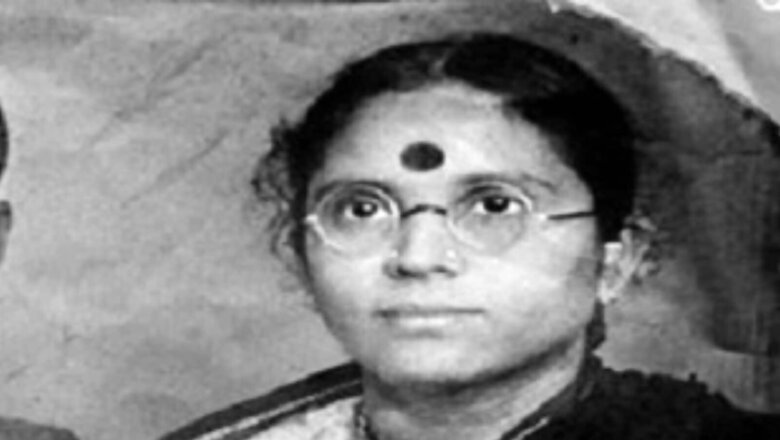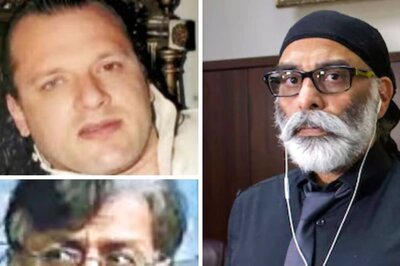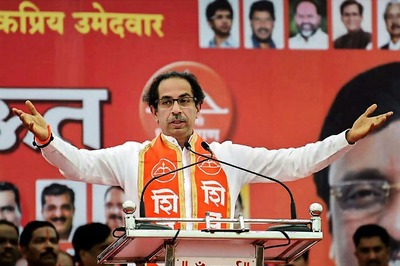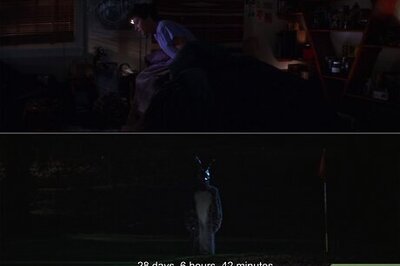
views
While travelling down memory lane, we find that there are so many unsung heroes of our pious land, who have contributed towards literary works, music, and freedom struggle, but have remained mostly unknown to the people of this era. One such person is Vaithamanithi Mudumbai Kothainayaki Ammal, whose journey has been full of unexpected struggles and turmoil and her inherent guts to have stood for what she believed in, is commendable.
Born in the year 1901, her fate was immediately sealed by her father’s friend Sri Srinivasa Appangar, who had named her Kothainayaki after the famous deity ‘Andal’ and seemed to have promised to take her as his daughter-in-law in the future. Unschooled as a child, she was married at the age of five and a half years to Parthasarathy, a nine-year-old then. Here, I should mention that child marriages were rampant then, and only a few girls had the privilege of having been sent to proper school or home tutored.
Kothainayaki Ammal belonged to the no-school category, but her mother-in-law took care of teaching her the Telugu language. She was proficient in chanting ‘Thiruvaimozhi’ which is a part of Divya Prabandham, a collection of 4000 Tamil verses. She was unlettered but her good fortune was that she got married into a scholarly family that provided her with the right environment for unfolding her creative talents later. Her husband encouraged her to watch plays and dramas so that she was never deprived to know what the outside world was and what it had to offer to society then. She was dreamily, imaginatively, so creative that she had always been good at spinning stories, which she couldn’t write on paper because of her being unlettered, a deficiency that was soon taken care of by her neighbour T.C. Pattamma, who taught Kothainayaki to read and write.
It was after this that she became unstoppable. Encouraged by her husband, she wrote and published her first play ‘Indira Mohana,’ in the year 1924, published by Novel Press. Over the next 30 years, she wrote about 115 books under the pen name Vai Mu Ko. As her tryst just began as a writer, in the year 1925, Vaduvur Doraiswami Iyengar, a well-known author then, suggested that she take over the magazine Jaganmohini which he had been running for the past two years. To her credit, within four months of taking over, she had 1000 subscribers. Hailing with a tag ‘orthodox Brahmanical family,’ others of her clan were so outraged by a Brahmin woman taking over as an editor of a magazine that they burnt copies of Jaganmohini, but in all this, Kothanayaki remained unperturbed, unfazed and unshaken. Such was her dedicated commitment towards an all-encompassing society.
Her first novel was ‘Vaidehi’ which was serialised in Jaganmohini and later brought out as a book by LIFCO publishers who are still publishing books, novels and shlokas. Her second novel was ‘Padma Sundaram’ which was translated into Malayalam. In her play ‘Vatsakumar,’ she criticised those who frowned upon the Bharatnatyam form of dance, as an immoral act.
Here, I should mention the fact that how writings of authors can have an impact in our society in a good progressive way. A fan of Kothainayaki Ammal, S. Ramanathan Chettiar, a resident of Saigon then, was so moved by one of her novels ‘Aparaadhi’ which advocated widow remarriage, that he arranged for the remarriage of many widows in his conservative community. Whenever he visited India, he made it a custom to visit Kothainayaki Ammal and buy copies of her novels so that when he returned to Saigon, he could give them to his relatives and friends.
Her life completely changed in 1925 when Mahatma Gandhi and Kasturba participated in a meeting exclusively arranged for mahilas (women) in the Vasanta Mantapam of Parthasarathy Temple in Triplicane, Chennai. During the course of the meeting, Kasturba appealed to the gathering to generously donate for taking forward the Harijan Service Movement. An orthodox Brahmin woman on hearing these words, came onto the stage, removed all her bangles, ring, nose rings, ear studs and placed them at the feet of Gandhiji.
After this, when she went back home which was just 100 meters away from the venue, everyone at home was looking at Kothainayaki Ammal astonishingly, trying to understand and comprehend what had just happened. Even more astonishing fact was that the whole family got convinced and willingly donated their might in the subsequent meetings. Such is her personality.
After meeting Gandhiji, she gave up on draping silk sarees and diamonds, and instead took to wearing Khadi. She didn’t stop with that and hawked Khadi on the streets of Madras. She gave speeches against British rule and participated in protest marches.
Once when Kothainayaki Ammal was shouting slogans in a protest march, the police tried to stop her by dousing her with sewer water, despite that she continued to raise slogans. With the failed attempts of the police force, they arrested her and sent her to the Vellore prison. From jail too, she didn’t want her magazine to stop, so she wrote the continuity on scraps of paper and smuggled them out of the prison through her ever-helping husband when he visited her in prison. For the first 13 years, she shouldered the entire burden of running the magazine.
She was so talented that with her self-efforts and her keen ear for music, she could compose songs in Telugu and Tamil. She had not only made solo music discs, but along with D K Pattammal, a well-known vocalist of those days, she made three discs under the Columbia label. Her house in Chennai also had eminent Carnatic singers like M S Subbalakshmi and Bangalore Nagaratnammal to have rendered songs. as Mahakavi Bharathi was a big fan of Kothainayaki’s renditions. All India Radio was started in 1938 and hers was the first voice heard on the radio. Later, she gave many radio programmes too.
Kothainayaki Ammal’s experience as a member of the Censor Board, which she held for 10 years, has to be mentioned. She had censored a scene in the film Adhirshtam, but the film got released with the scene sneaked in and without the legitimate cut. She got furious and ensured that the scene was cut with immediate effect. A woman of substance, an extremely avid supporter of social bondages and women’s emancipation, she wasn’t afraid to tell what was in her mind always. She wrote fearlessly about everything in her magazine Jaganmohini, where she spoke of the social issues in a woven story form, which would eventually reach the readers’ hearts and minds and would make the desired impact in their lives. She was against toddy and alcohol consumption.
Kothainayaki Ammal was officially recognised as the first Tamilian woman to write a detective novel, but her works were barely documented in Tamil literature. Her magazine raced to the top and became one of the bestsellers too.
After the death of Gandhiji in 1948, she started an association called Mahatmaji Seva Sangam, where girls were taught music, dance, public speaking and Hindi. She organised concerts and lectures at the Sangam.
She stayed humble and strong-willed all through her life. Darkness crept into her life when her only son died in 1956. It was after this setback that her ever-beating heart decided that she couldn’t take it anymore and fell into a pit of never-ending despair. The world bid adieu to this brave blazing light on 20 February, 1960, leaving behind a legacy, incomparable to her stature of being an all-rounder.
In the 1900s, it was normal for girls to remain uneducated as there was no awareness of “Beti Bachao Beti Padhao.” They were married at school going age. Kothainayaki Ammal though got married into an orthodox Brahmin family, she was able to do and achieve all these things only because of her husband who held progressive views and helped her in every possible way.
All good things in life don’t last forever. Ammal’s magazine was closed in 1959 and two years after her death, a letter was delivered to her house with no specific address and just read ‘Jaganmohini Madras.’ The ironical fact is that the existing family members are not in possession of a single copy of her novels and plays, but last seen and heard, copies of 72 Jaganmohini magazine and 65 of her grandmother’s novels were at Calcutta Central Library as narrated by her grandson Venkatakrishnan. There is still a small board outside the family’s ancestral house in Triplicane, Chennai, which reads ‘Jaganmohini,’ the only vestige of a once popular magazine, which had been published uninterruptedly for 35 years.
The author is Chennai-based advocate. Views expressed are personal.
Read all the Latest Opinions here



















Comments
0 comment